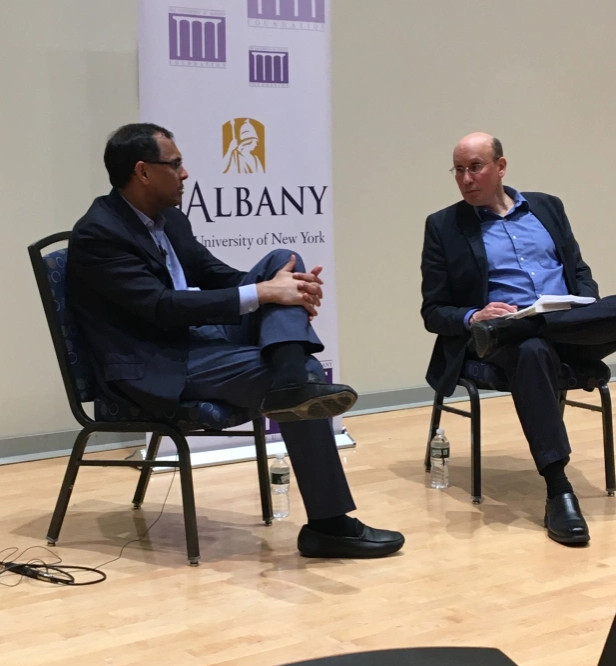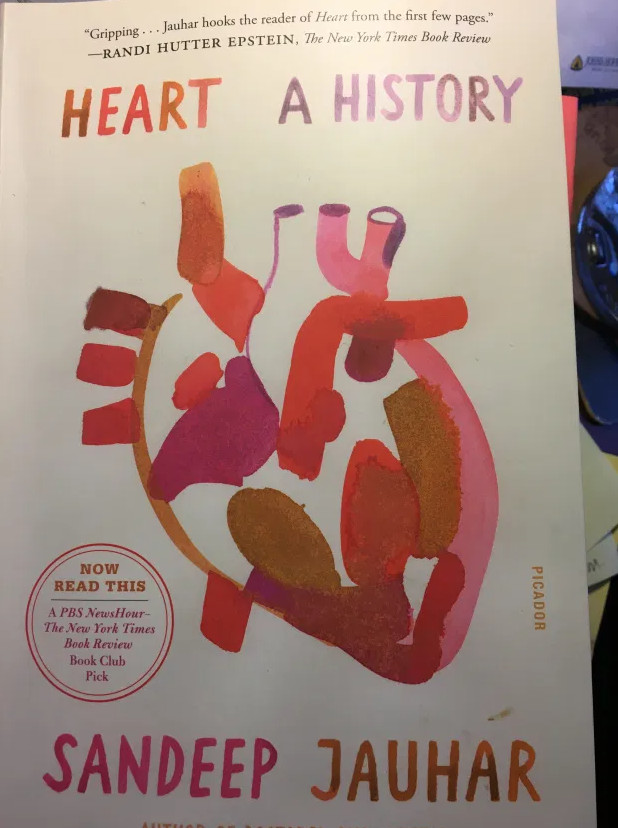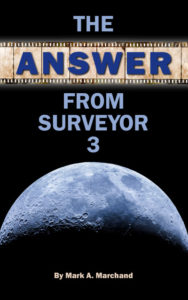There is such a thing as broken heart syndrome.
This realization followed a recent New York State Writers Institute event featuring cardiac expert Sandeep Jauhar, M.D., Ph.D. I enjoy listening to and talking with scientists and doctors who have a knack for helping the masses understand science and medicine. I wasn’t disappointed by Jauhar’s talk. I came away with new appreciation for an organ so complex that it was the last holdout for organs that could be surgically repaired. For centuries, doctors found ways to operate on almost every organ in the human body—except the live heart. Stitching or cutting a tough, constantly moving and electrically stimulated muscle with a network of chambers wasn’t even attempted until the late 19th century. In 1893 Daniel Williams of Howard University surgically repaired the heart of a man dying from a knife wound. Two months after the stabbing, the patient walked out of the hospital and lived a normal life. The march toward the last frontier of lifesaving organ surgery was on.

Dr. Jauhar, left, talks with New York State Writers Institute Assistant Director Mark Koplik
Jauhar’s new book “Heart: A History,” is filled with fascinating information about the heart—some good, and some scary—that underscores the importance of the muscular organ. Consider this: From birth to death the human heart beats about three billion times. Each heartbeat generates enough force to push blood through about 100,000 miles of vessels. And the amount of blood that passes through an average adult heart in one week could fill a swimming pool. Some bad news: Cardiovascular disease claims 18 million lives annually, earning a place as the No. 1 cause of death in America.
Jauhar became fascinated with the human heart growing up in his native India. His paternal grandfather died of a sudden heart attack at age 57, 15 years before Jauhar was born. The suddenness of the death and accompanying decades of grief became part of family lore and fueled an obsession that eventually led Jauhar to a lifetime of studying and practicing heart medicine. So many causes of death, he says, play out over time, such as cancer and Parkinsons. Not so with heart attacks, which swoop in and rob a family of a loved one in an instant. In his book, he says, “…I grew up with a fear of the heart as the executioner of men in the prime of their lives. Because of the heart, you could be healthy and still die; it seemed like such a cheat.”
Jauhar recalls lying on his bed growing up, watching the revolutions of a ceiling fan while listening to the thudding of his heart. “I’d adjust the speed of the ceiling fan to synchronize with my heartbeat, in thrall to the two competing oscillators, so grateful that mine never took a rest.”
So what about that broken heart? Jauhar loves to talk about two hearts: the biological, never-resting organ and the metaphorical heart—the center of humanness that for centuries was viewed as the core of our bodies. The metaphorical heart encompasses love, depression, a soul, character, fear, courage, and so many other aspects of our lives relating to who we are and how we live. That heart inspired poets, painters, and writers. Of course, we now know that’s not physically true, Jahaur says, but, “…we nevertheless continue to subscribe to the heart’s symbolic connotations.”

Dr. Jauhar, during his Writers Institute talk at UAlbany
Along with other heart failure specialists at Long Island Jewish Medical center, Jauhar has focused on empirical connections between the biological and metaphorical organs, especially the impact of sudden, severe stress on an otherwise healthy heart. It has a medical name: takotsubo cardiomyopathy. The word takotsubo comes from the name of a vase-shaped Japanese octopus trap. The name was chosen because sudden stress causes the left ventricle of a heart to change shape, resembling the trap. The changing form and enlargement of that heart chamber rapidly degrade heart performance. Thus, the condition results from the close intersection of the metaphorical heart with the biological one.
Jauhar says the primary mechanism for sudden cardiac arrest in someone experiencing intense emotional disturbance lies in the human autonomic nervous system, which regulates unconscious movements like heartbeat and breathing. Within that system are two divisions. The first, sympathetic, is responsible for reactions like the rising heart rate and blood pressure of “fight or flight.” The second, the parasympathetic system, has the opposite effect of slowing respiration and heartbeat. What Jauhar and others have learned over the past several decades is that intense stress causes an autonomic “storm” on the heart, emerging from the sympathetic and parasympathetic components. The result—whether it’s caused by a sudden release of adrenaline or longer-term grief—leads to cardiac events in the wake of the patient learning of a sudden death, the end of a close relationship, or another type of emotional loss or fear. In one year studied by researchers, Jauhar explains, there were 22,000 U.S. patients documented with takotsubo. These cases were traced to events ranging from widespread, destructive weather events like tornadoes and hurricanes to emotional upsets.
The link exists and heart doctors like Jauhar say they need to focus on understanding or simply recognizing patients’ emotional states, stresses, worries, and fears. “Stress management is clearly associated with a reduction in heart problems,” he told his Writers Institute audience. “It affects survival more than most realize.”
Beware the broken heart. Learn to better manage stress or your reaction to sudden fright. Your life just might depend on it.




